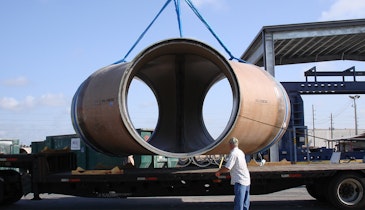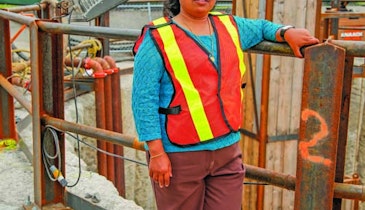T |
he Los Angeles County Metropolitan Transportation Authority is in the final stages of constructing an underground light rail trunk line that will allow riders to travel through downtown Los Angeles. Known as the Metro Regional Connector Transit Project, it will connect three existing light rail transit systems through downtown.
Regional Connector Constructors — a joint venture of Skanska USA Civil West California District in partnership with Traylor Bros. — was awarded the design-build contract by the LA Metro to construct this 1.9-mile completely underground transit way through downtown Los Angeles.
While the tunnels for the twin rail lines were excavated with a 400-foot tunnel boring machine, the stations were excavated by opencut. In order to open cut to the needed depths in a high density metropolitan area, the contractors first had to safely get past numerous older utilities, many of which needed repair or replacement. The historic Broadway Station was the most challenging to construct due to having the most congested existing underground utilities in the area, including a 10-foot diameter reinforced concrete storm drain that had been constructed around 1960.
A creative construction sequencing plan devised by RCC would expose the existing utilities along the 400-foot station zone to make any repairs or replacements. These exposed utility lines would then be suspended for perhaps as long as four years over what would soon be 50 to 60 feet of air.
REPLACING THE STORM DRAIN
The electrical, telephone, fiber optic and natural gas lines were easily enclosed in a suspended casing, but the 10-foot diameter reinforced concrete storm drain belonging to the LA Flood Control Department was a larger and heavier challenge. The contractors immediately realized that due to its weight and uncertain structural integrity, the existing concrete storm drain would have to be either rerouted or replaced with something lighter. HOBAS Pipe was chosen as the lighter, stronger, less expensive and more efficient option for the project.
A temporary support system for the pipe installation was devised using vertical supports and a series of threaded rods to attach nylon web slings that would suspend the pipe from the temporary ceiling/supporting deck beams for the Second Street decking. The pipe was secured at grade with turnbuckles and ultimately with lateral and longitudinal braces. There it would remain suspended for the remainder of the excavation, station build-out, and backfill to the pipe’s grade.
As the new 300-foot line neared completion, the existing reinforced concrete storm drain was removed up to a couple of feet above its invert. This work was done during Los Angeles’ dry season from April to October to take advantage of the low flow at that time of year. A sandbag dam and pump were able to handle the minimal base flow during the construction of cast-in-place transition structures to connect the new line to the existing storm drain at either end of the cavern. Upon completion of the connection, the remaining lower portion of the reinforced concrete was removed.
The new section of 126-inch HOBAS reinforced concrete storm drain, totally and permanently encased, will continue serving the LA Flood Control Department and the citizens of Los Angeles indefinitely.
HOBAS Pipe USA manufactures fiberglass reinforced polymer mortar pipe from 18 to 126 inches in diameter. With over 10 million feet installed across North America, engineers and contractors regularly select HOBAS pipe due to its light weight, high strength, ease of installation and leak-free push together joints. It is suitable for a variety of installation methods including sliplining and other trenchless methods, open cut and above ground. It is also suitable for new construction and rehab of critical installations including storm and sanitary sewers, hydroelectric penstocks and other corrosive environments. HOBAS also provides fully structural FRP noncircular pipe and vertical manhole systems.
281-821-2200 | www.hobaspipe.com





